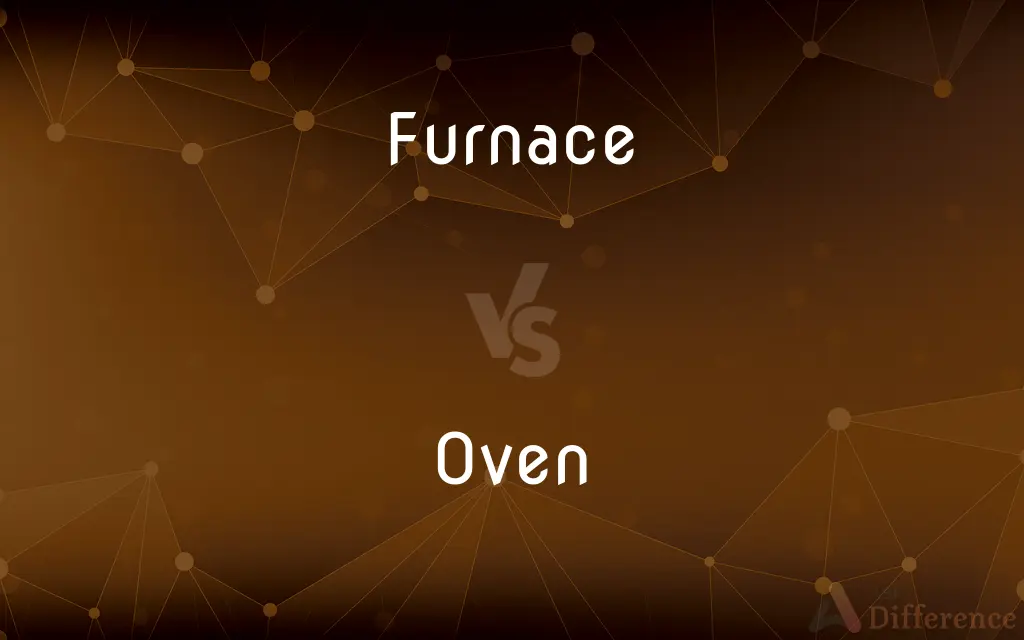Furnace vs. Oven — What's the Difference?
By Tayyaba Rehman & Maham Liaqat — Updated on March 8, 2024
A furnace is primarily used for heating spaces or materials to very high temperatures, while an oven is designed for cooking and baking at controlled temperatures.

Difference Between Furnace and Oven
Table of Contents
ADVERTISEMENT
Key Differences
A furnace is designed to generate high heat for various purposes, including heating homes and melting metals, whereas an oven is specifically made for cooking and baking food at controlled temperatures. Furnaces operate at much higher temperatures and are part of a building's central heating system or used in industrial processes, while ovens are generally standalone appliances found in kitchens.
Furnaces can be powered by electricity, gas, or oil, providing a central heating source that distributes warmth throughout a space. On the other hand, ovens typically use electricity or gas to heat food evenly, often featuring settings for broiling, baking, and roasting.
Furnaces play a crucial role in metallurgy and other industrial processes where very high temperatures are required, such as for forging metals or producing ceramics. In contrast, ovens are essential in the culinary world, with specialized types like convection ovens that use a fan to circulate hot air for faster, more even cooking.
The design of a furnace is focused on efficient heat generation and distribution, often incorporating blowers to circulate hot air through ducts in a home or facility. Ovens, however, are designed with food preparation in mind, including features like temperature control, timers, and racks to accommodate different types of dishes.
While both furnaces and ovens are essential for their respective uses, the key difference lies in their application and operation temperatures. Furnaces are vital for heating and industrial processes, while ovens are indispensable tools in cooking and baking.
ADVERTISEMENT
Comparison Chart
Primary Use
Heating buildings or industrial materials
Cooking and baking food
Temperature Range
Very high, for heating and industrial processes
Controlled, for food preparation
Power Source
Electricity, gas, oil
Electricity, gas
Role in Industry
Crucial for metallurgy, forging, ceramics
Essential in culinary, food preparation
Design Focus
Efficient heat generation and distribution
Even heating, temperature control, cooking features
Compare with Definitions
Furnace
Heating Device.
The furnace heated the entire house during the winter months.
Oven
Cooking Appliance.
She baked the cake in an electric oven at 350 degrees Fahrenheit.
Furnace
Industrial Equipment.
The steel was melted in a blast furnace for shaping.
Oven
Baking and Roasting.
The oven's convection setting made the roast chicken crispy and evenly cooked.
Furnace
Energy Source Variety.
Modern furnaces can operate on gas, oil, or electricity.
Oven
Specialized Types.
The pizza was cooked in a wood-fired oven for an authentic taste.
Furnace
High-Temperature Operations.
Ceramics require a furnace capable of reaching very high temperatures.
Oven
Kitchen Essential.
Every modern kitchen is equipped with an oven for daily cooking needs.
Furnace
Central Heating Component.
The new furnace can efficiently distribute heat through ducts.
Oven
Temperature Control.
The oven's precise temperature control is perfect for delicate pastries.
Furnace
A furnace, referred to as a heater or boiler in British English, is a heating unit used to heat up an entire building. Furnaces are mostly used as a major component of a central heating system.
Oven
An oven is a tool which is used to expose materials to a hot environment. Ovens contain a hollow chamber and provide a means of heating the chamber in a controlled way.
Furnace
An enclosure in which energy in a nonthermal form is converted to heat, especially such an enclosure in which heat is generated by the combustion of a suitable fuel.
Oven
A chamber or enclosed compartment for heating, baking, or roasting food, as in a stove, or for firing, baking, hardening, or drying objects, as in a kiln.
Furnace
An intensely hot place
The furnace of the sun.
An attic room that is a furnace in the summer.
Oven
A chamber used for baking or heating.
Furnace
A severe test or trial
Endured the furnace of his friends' blame after the accident.
Oven
(colloquial) A very hot place.
Furnace
(UK) An industrial heating device, e.g. for smelting metal or baking ceramics.
Oven
To cook in an oven
Furnace
A device that provides heat for a building; a space heater.
Oven
A place arched over with brick or stonework, and used for baking, heating, or drying; hence, any structure, whether fixed or portable, which may be heated for baking, drying, etc.; esp., now, a chamber in a stove, used for baking or roasting.
Furnace
(colloquial) Any area that is excessively hot.
Oven
Kitchen appliance used for baking or roasting
Furnace
(figurative) A place or time of punishment, affliction, or great trial; severe experience or discipline.
Furnace
To heat in a furnace.
Furnace
To exhale like a furnace.
Furnace
An inclosed place in which heat is produced by the combustion of fuel, as for reducing ores or melting metals, for warming a house, for baking pottery, etc.; as, an iron furnace; a hot-air furnace; a glass furnace; a boiler furnace, etc.
Furnace
A place or time of punishment, affiction, or great trial; severe experience or discipline.
Furnace
To throw out, or exhale, as from a furnace; also, to put into a furnace.
He furnacesThe thick sighs from him.
Furnace
An enclosed chamber in which heat is produced to heat buildings, destroy refuse, smelt or refine ores, etc.
Common Curiosities
Can you cook food in a furnace?
No, furnaces are not designed for cooking food; they are used for heating or industrial purposes.
What types of ovens are there?
There are several types of ovens, including conventional, convection, and specialized ovens like pizza ovens.
How do ovens control temperature?
Ovens control temperature through thermostats and settings that allow precise heat regulation for cooking and baking.
Can ovens be powered by gas?
Yes, ovens can be powered by either gas or electricity.
Is a furnace necessary in all homes?
Not all homes require a furnace; it depends on the climate and heating needs.
What is the primary use of a furnace?
A furnace is mainly used for heating spaces or for industrial processes requiring high temperatures.
What is a blast furnace?
A blast furnace is a type of industrial furnace used for smelting to produce industrial metals, typically iron.
Are furnaces used in residential settings?
Yes, furnaces are commonly used in residential settings for central heating.
What is the energy efficiency of modern ovens?
Modern ovens are designed to be more energy-efficient, with features like better insulation and energy-saving modes.
What makes a convection oven different?
A convection oven uses a fan to circulate hot air, promoting faster and more even cooking.
How does an oven benefit cooking?
An oven allows for controlled, even heating, making it ideal for baking, roasting, and other cooking methods.
What maintenance does a furnace require?
Regular maintenance for a furnace includes filter changes, duct cleaning, and inspections to ensure efficiency and safety.
Can ovens have special features for specific foods?
Yes, some ovens come with special features like pizza or bread proofing settings.
Can a furnace be used for cooking in an emergency?
While not designed for cooking, in emergencies, some improvisation may be possible but not recommended.
How long do furnaces typically last?
With proper maintenance, a furnace can last between 15 to 20 years.
Share Your Discovery

Previous Comparison
Dignity vs. Respect
Next Comparison
Reinforcement vs. PunishmentAuthor Spotlight
Written by
Tayyaba RehmanTayyaba Rehman is a distinguished writer, currently serving as a primary contributor to askdifference.com. As a researcher in semantics and etymology, Tayyaba's passion for the complexity of languages and their distinctions has found a perfect home on the platform. Tayyaba delves into the intricacies of language, distinguishing between commonly confused words and phrases, thereby providing clarity for readers worldwide.
Co-written by
Maham Liaqat















































